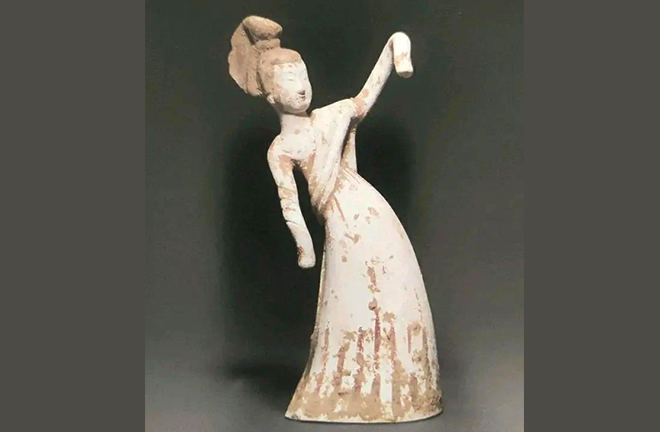Dance art of Tang Dynasty

FILE PHOTO: A Tang Dynasty pottery dancer
Tang Dynasty dance can be divided into two main categories: vigorous dance (jian wu) and soft dance (ruan wu), both of which were deeply influenced by the dances of Western regions.
Vigorous dance, as the name suggests, is characterized by energetic and robust movements, often performed with a lively and fast-paced rhythm. Representative vigorous dance types include the Hu Xuan, Hu Teng, Tuo Zhi, and sword dances. The Hu Xuan, also known as the Sogdian Whirl dance, was probably imported into China in the first half of the first millennium CE. This dance is characterized by its distinct spinning movements, with dancers continuously rotating to present a lively and joyful atmosphere. The Hu Teng dance, originating in Central Asia, is a solo male dance characterized by leaps and varied stamping steps.The Tuo Zhi dance originates from an ancient kingdom in present-day Tashkent, Uzbekistan. Performed to the accompaniment of drums, the dancers enter and begin their performance with distinctive rhythms, creating an intense and lively atmosphere. The sword dance, on the other hand, carries the essence of Central Plains culture, with dancers wielding swords and performing powerful movements, embodying the demeanor of warriors.
In contrast, soft dance features graceful and gentle movements with a slow rhythm. Famous soft dances include “Green Waist” and “Spring Oriole’s Warble.” These dances showcase the dancers’ graceful postures and delicate emotional expressions. “Green Waist” is a female solo dance characterized by the dancer’s beautiful waist movements, with light steps and elegant poses. “Spring Oriole’s Warble” is a solo female dance that combines the style of Kucha music and dance and is characterized by elegant steps forward and backward. This dance style was introduced to Japan during the Tang Dynasty, where it evolved into a form in which men danced wearing bird-like masks.
Edited by REN GUANHONG
